Politics
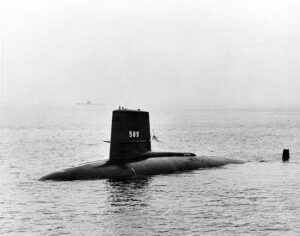
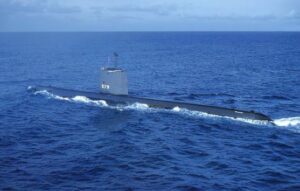 USS Scorpion (SSN-589) was a Skipjack-class nuclear-powered submarine that served in the United States Navy, and the sixth vessel, and second submarine, of the US Navy to carry that name. It was also the fourth nuclear powered submarine to mysteriously go missing in 1968. Scorpion was lost with all its crew, on May 22, 1968. Scorpion is one of two nuclear submarines the US Navy has lost, the other being USS Thresher. The other nuclear-powered submarines to go missing in 1968 at the height of the Cold War were Israeli submarine INS Dakar, the French submarine Minerve, and the Soviet submarine K-129. At the time Scorpion went missing when she was sent to surveil the Soviet submarine K-129, which had apparently already gone missing earlier in the year. The wreckage of USS Scorpion is still at the bottom of the North Atlantic Ocean…with all its armaments and nuclear engine.
USS Scorpion (SSN-589) was a Skipjack-class nuclear-powered submarine that served in the United States Navy, and the sixth vessel, and second submarine, of the US Navy to carry that name. It was also the fourth nuclear powered submarine to mysteriously go missing in 1968. Scorpion was lost with all its crew, on May 22, 1968. Scorpion is one of two nuclear submarines the US Navy has lost, the other being USS Thresher. The other nuclear-powered submarines to go missing in 1968 at the height of the Cold War were Israeli submarine INS Dakar, the French submarine Minerve, and the Soviet submarine K-129. At the time Scorpion went missing when she was sent to surveil the Soviet submarine K-129, which had apparently already gone missing earlier in the year. The wreckage of USS Scorpion is still at the bottom of the North Atlantic Ocean…with all its armaments and nuclear engine.
The Cold War is a term commonly used to refer to a period of geopolitical tension between the United States and the Soviet Union and their respective allies, the Western Bloc and the Eastern Bloc. The first phase of the Cold War began shortly after the end of World War II in 1945. The United States and its allies created the NATO military alliance in 1949 in the apprehension of a Soviet attack and termed their global policy against Soviet influence containment.
Following World War II, tensions were running high between world powers. It is thought that if there was ever a time when a real possibility of a nuclear attack existed, it was during the Cold War. This meant that countries were frantically looking for any advantage they could use to take over their competitors. One way to watch the other countries was to Surveil beneath the waves where they could be more hidden. This surveillance included the use of submarine crews. That, of course, explains the reason for mysterious disappearance of four subs from four different countries virtually at the same time.
The first disappearance was the INS Dakar from Israel, which went down just east of Crete on January 25, 1968. Dakar’s wreckage was found in 1991, but no official cause for the sinking was determined. Next, The French sub Minerve disappeared about an hour outside of Toulon on January 27, 1968. That wreckage was found in 2019, and it showed the hull had separated into three sections. When the French government made the decision to leave the wreck, any chance of answers was eliminated. The Soviet K-129 disappeared earlier in the year, so maybe USS Scorpion was looking for it. Nevertheless, on May 22, 1968, the disappearance conspiracy of 1968 was brought to a close, when USS Scorpion. The submarine would not be fount until October of 1968. The Navy looked into the disaster, but in the end the official court of inquiry said the cause of the loss could not be determined with certainty. Still, there are several theories on what might have happened. One centered around a malfunction of a torpedo. Others suspected poor maintenance may have been the culprit, citing the rushed overhaul.
That was the last report anyone heard about the submarine. After decades of research and investigation, the US Navy has never changed its report that a catastrophic event caused the sinking. Nevertheless, there are those who believe the Scorpion was taken out by the Soviets in retaliation for perceived attack on the K-129 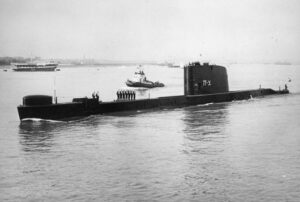
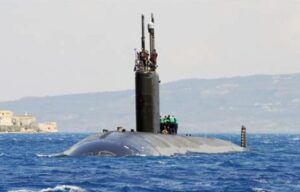 submarine earlier in the year. Neither country will admit or deny any direct action relating to the submarine sabotage, but something happened during the first half of 1968. Four nuclear-powered submarines, from four different countries just don’t start sinking for no reason, and yet, no reason was ever determined. They just sunk.
submarine earlier in the year. Neither country will admit or deny any direct action relating to the submarine sabotage, but something happened during the first half of 1968. Four nuclear-powered submarines, from four different countries just don’t start sinking for no reason, and yet, no reason was ever determined. They just sunk.

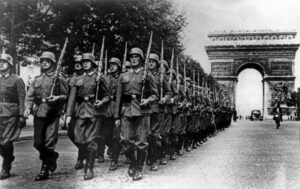 During World War II and even earlier really, Adolf Hitler was in the middle of his plan to take over the world. He was ruthless, and when he invaded a country, he didn’t care how many people died, as long as he got his way. The Battle of France took place between May 10, 1940 and June 25, 1940. The surrender of France to the Nazis in 1940 was a complex situation. The German invasion left metropolitan France at the mercy of Nazi armies. Really, once Paris fell on June 14, 1940, the German conquest of France was complete. Part of the problem was that Marshal Henri Petain replaced Paul Reynaud as prime minister and proved to be a weak leader who announced his intention to sign an armistice with the Nazis.
During World War II and even earlier really, Adolf Hitler was in the middle of his plan to take over the world. He was ruthless, and when he invaded a country, he didn’t care how many people died, as long as he got his way. The Battle of France took place between May 10, 1940 and June 25, 1940. The surrender of France to the Nazis in 1940 was a complex situation. The German invasion left metropolitan France at the mercy of Nazi armies. Really, once Paris fell on June 14, 1940, the German conquest of France was complete. Part of the problem was that Marshal Henri Petain replaced Paul Reynaud as prime minister and proved to be a weak leader who announced his intention to sign an armistice with the Nazis.
While not very well known at the time, French General Charles de Gaulle, made a broadcast on June 18, 1940, to France from England, where he would help with the resistance. The Appeal of June 18 was the first speech made by Charles de Gaulle after his arrival in London in 1940 following the Battle of France. The speech was broadcast to Vichy France by the radio services of the British Broadcasting Corporation (BBC). This speech is considered to have marked the beginning of the French Resistance in World War II. It is regarded as one of the most important speeches in French history. General de Gaulle said in his speech, “The leaders who, for many years, were at the head of French armies, have formed a government. This government, alleging our armies to be undone, agreed with the enemy to stop fighting. Of course, we were subdued by the mechanical, ground and air forces of the enemy. Infinitely more than their number, it was the tanks, the airplanes, the tactics of the Germans which made us retreat. It was the tanks, the airplanes, the tactics of the Germans that surprised our leaders to the point to bring them there where they are today.
But has the last word been said? Must hope disappear? Is defeat final? No!
Believe me, I speak to you with full knowledge of the facts and tell you that nothing is lost for France. The same means that overcame us can bring us to a day of victory. For France is not alone! She is not alone! She is not alone! She has a vast Empire behind her. She can align with the British Empire that holds the sea and continues the fight. She can, like England, use without limit the immense industry of United States.
This war is not limited to the unfortunate territory of our country. This war is not finished by the battle of France. This war is a world wide war. All the faults, all the delays, all the suffering, do not prevent there to be, in the world, all the necessary means to one day crush our enemies. Vanquished today by mechanical force, we will be able to overcome in the future by a superior mechanical force.
The destiny of the world is here. I, General de Gaulle, currently in London, invite the officers and the French soldiers who are located in British territory or who would come there, with their weapons or without their weapons, I invite the engineers and the special workers of armament industries who are located in British territory or who would come there, to put themselves in contact with me.
Whatever happens, the flame of the French resistance must not be extinguished and will not be extinguished.”
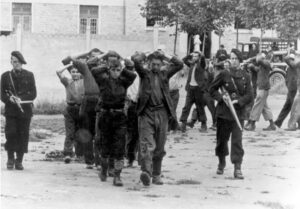
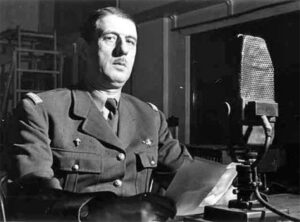 His work with the French Resistance made Charles de Gaulle almost a household word in France. It gave the people hope for freedom. The French Resistance fought to the death to beat the Nazis. This makes me think of current times, and all the freedoms that we have lost. These lessons from the French Resistance are valuable to this day. Never give up. You only lose a battle when you quit fighting. We must never quit fighting.
His work with the French Resistance made Charles de Gaulle almost a household word in France. It gave the people hope for freedom. The French Resistance fought to the death to beat the Nazis. This makes me think of current times, and all the freedoms that we have lost. These lessons from the French Resistance are valuable to this day. Never give up. You only lose a battle when you quit fighting. We must never quit fighting.
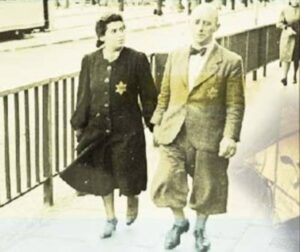
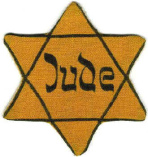 Like the week in 1941, that changed the lives of Jewish people everywhere and set in motion the most horrific mass bullying and murders in history, our own government has also been trying to force mandates and executive orders on us too. You might say that the mandates of today are not nearly as bad as the Holocaust years, and I would say that you are right, they aren’t as bad…yet!! That horrific week for the Jewish people started on September 1, 1941, when the German Government ordered that all Jews in Germany over six-years-old must wear the Judenstern…a Star of David that was colored yellow and inscribed Jude (Jew) in mock-Hebrew lettering. The action was designed to humiliate, bully, and later set up mass killings of an entire race of people, and it was ordered by one of the most evil people that ever walked the face of the earth…Adolf Hitler. The supposed mark of shame would, in postwar years, become a symbol of the horrific persecution and the Holocaust.
Like the week in 1941, that changed the lives of Jewish people everywhere and set in motion the most horrific mass bullying and murders in history, our own government has also been trying to force mandates and executive orders on us too. You might say that the mandates of today are not nearly as bad as the Holocaust years, and I would say that you are right, they aren’t as bad…yet!! That horrific week for the Jewish people started on September 1, 1941, when the German Government ordered that all Jews in Germany over six-years-old must wear the Judenstern…a Star of David that was colored yellow and inscribed Jude (Jew) in mock-Hebrew lettering. The action was designed to humiliate, bully, and later set up mass killings of an entire race of people, and it was ordered by one of the most evil people that ever walked the face of the earth…Adolf Hitler. The supposed mark of shame would, in postwar years, become a symbol of the horrific persecution and the Holocaust.
Throughout history, the Jewish people have been persecuted and forced to distinguish themselves in similar ways. Prior to September 1st, the Nazis had already demanded that Jews in the East, including Poland, wear the Star of David. The only difference was that in Poland the stars were colored blue instead of yellow. The rest of the bullying, humiliation, and hatred were the same. Still, as with any brutal treatment of a group of people, not everyone agreed with this horrific practice and ordinance. In fact, the Yellow Star Law was very unpopular with the average German citizens, and many of them would tip their hat as a show of respect to the Jewish people as they passed them in the street. Of course, the Nazis couldn’t allow that to continue, and the German authorities quickly forbade the practice of hat tipping, because it was a defiance of their law. The Occupied Zone of France, stalled the law until June of 1942, and Vichy never put it in place even though they were very proactive in persecuting Jews in the Free Zone.
The Yellow Star Law basically made it legal for millions of Jews to be bullied, beaten, and murdered…by any means, and all without any form of punishment for it. That sounds much like the present day (although now over with) Mask Mandates of today. In what was just the beginning of the horror, The Yellow Star Law gave the 
 German Army the right to kill a Jew in broad daylight, with witnesses, and no punishment. The Jewish people couldn’t own property, have a business, or even own a home and its contents. They were moved into ghettos and their property was stolen from them. In modern days, we often look at this kind of practice as not possible, but if we don’t watch our government closely, we may find ourselves in very much the “same boat” as the Jewish people of the Holocaust years. Be aware…be very aware.
German Army the right to kill a Jew in broad daylight, with witnesses, and no punishment. The Jewish people couldn’t own property, have a business, or even own a home and its contents. They were moved into ghettos and their property was stolen from them. In modern days, we often look at this kind of practice as not possible, but if we don’t watch our government closely, we may find ourselves in very much the “same boat” as the Jewish people of the Holocaust years. Be aware…be very aware.

 These days, we have probably seen more “shortages” of the staples needed for daily life than ever before. Things like food, water, toilet paper, sugar, gasoline, and so many other things that most people use every day, are suddenly missing from our shelves or stations. Today’s “shortages” are mostly caused by forced blocking of shipping channels, and other political maneuvering…at least these days. There are as many reasons for most shortages as there are shortages, in reality, but some shortages have been stranger over the years than others. Sometimes, it’s even for our own good or if it is “perceived” to be for our own good.
These days, we have probably seen more “shortages” of the staples needed for daily life than ever before. Things like food, water, toilet paper, sugar, gasoline, and so many other things that most people use every day, are suddenly missing from our shelves or stations. Today’s “shortages” are mostly caused by forced blocking of shipping channels, and other political maneuvering…at least these days. There are as many reasons for most shortages as there are shortages, in reality, but some shortages have been stranger over the years than others. Sometimes, it’s even for our own good or if it is “perceived” to be for our own good.
Things have been pulled off the shelves because of recalls, like vegetables that may have Salmonella, and even if the source was confined to one small area of one plant, as was the case with baby formula. The government shut down all the plants, causing a serous baby formula shortage. No one wants to buy unsafe formula, but that was really never the case, and they knew it. Excedrin was pulled off the shelves because it “might” have an ingredient that was unsafe, and then weeks later, it was back, in exactly the same formulation.
The closing of a business is one of the biggest reasons for items to suddenly be missing from the shelves. 
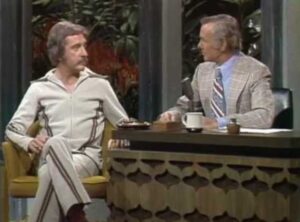 Twinkies is a prime example. When Hostess Brands Inc, the maker of Twinkies and other cherished American treats, announced bankruptcy and closure in 2012, consumers made a mad rush to their local supermarkets to get their hands on the cream-filled pastries before they were gone for good. It is that act that prompted the myth that Twinkies have an unlimited shelf life. The snacks were back on the shelves by summer, when Hostess and all of its brand holdings, including Twinkies, were purchased out of bankruptcy by the private equity firms Apollo Global Management and Metropoulos and Company in 2013.
Twinkies is a prime example. When Hostess Brands Inc, the maker of Twinkies and other cherished American treats, announced bankruptcy and closure in 2012, consumers made a mad rush to their local supermarkets to get their hands on the cream-filled pastries before they were gone for good. It is that act that prompted the myth that Twinkies have an unlimited shelf life. The snacks were back on the shelves by summer, when Hostess and all of its brand holdings, including Twinkies, were purchased out of bankruptcy by the private equity firms Apollo Global Management and Metropoulos and Company in 2013.
One of the funniest shortages, though not funny at the time or in the repeat of it in recent times, was the 1973 toilet paper shortage. It happened as the result of a joke by Johnny Carson. He said, “You know, we’ve got all sorts of shortages these days. But have you heard the latest? I’m not kidding. I saw it in the papers. There’s an acute shortage of toilet paper.” The remarks that were meant as a joke, caused people to rush to the stores and buyout all the toilet paper. To make matters worse, some stores began rationing. Finally, Carson took to the airwaves to apologize, saying, “I don’t want to be remembered as the man who created a false toilet paper scare. I just picked up the item from the paper and enlarged it somewhat…there is no shortage.”


There are so many ways a shortage can get started. Some are real events, while others are manufactured. While some are not exactly detrimental, as was the case with Twinkies, some can cause serious harm and even death…even many deaths. Some shortages cannot be helped, but those that can, in all prudence, should be avoided at all costs.
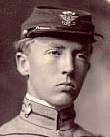
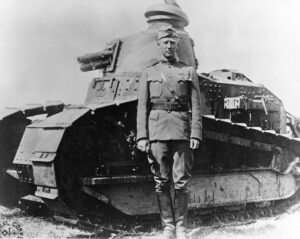 There are men of war, and then there are men of war. United States General George S Patton was the latter…meaning that he almost lived for war. Patton was a man who came from a long line of military people, and while he wasn’t always a tactful man, he was a great warrior…a fact that he proved over and over again. Many people didn’t like him much, but they couldn’t deny his capabilities. Patton was a great leader, but he wasn’t really a people person, and that got him in some trouble.
There are men of war, and then there are men of war. United States General George S Patton was the latter…meaning that he almost lived for war. Patton was a man who came from a long line of military people, and while he wasn’t always a tactful man, he was a great warrior…a fact that he proved over and over again. Many people didn’t like him much, but they couldn’t deny his capabilities. Patton was a great leader, but he wasn’t really a people person, and that got him in some trouble.
George Smith Patton Jr, who was born to George Smith Patton Sr and his wife, Ruth Wilson, the daughter of Benjamin Davis Wilson on November 11, 1885, in San Gabriel, California. Maybe because of his family history, or maybe it was just him, but Patton never seriously considered a career other than the military. At the age of seventeen he tried for an appointment to the United States Military Academy at West Point, New York. He also applied to several universities with Reserve Officer’s Training Corps programs, and was accepted to Princeton College, but eventually decided on Virginia Military Institute (VMI), which his father and grandfather had attended. Later, after studying at West Point, he served as a tank officer in World War I. Patton loved the tank, and his time as a tank officer, as well as his military strategy studies led him to become an advocate of the crucial importance of the tank in future warfare. When the United States entered World War II, Patton became the logical choice for the command of an important US tank division, and his division played a key role in the Allied invasion of French North Africa in 1942. Then, in 1943, in the Allied assault on Sicily, Patton and the US 7th Army in its assault on Sicily and won fame for out-commanding Montgomery during their pincer movement against Messina. Patton loved competition, and this was his chance to shine. On August 17, 1943, Patton and his 7th Army arrived in Messina several hours before British Field Marshal Bernard L Montgomery and his 8th Army, winning the unofficial “Race to Messina” and completing the Allied conquest of Sicily.
Although Patton was one of the most capable American commanders in World War II, he was also one of the most controversial. Patton was a “pull yourself up by your bootstraps” kind of guy, and therefore had no personal understanding of fear or fatigue. PTSD, battle fatigue, or shell shock were conditions he could not accept in anyone. In fact, they infuriated him so much that he actually slapped two soldiers who were suffering with the conditions. During the Sicilian campaign, Patton generated considerable controversy when he accused a hospitalized US soldier suffering from battle fatigue of cowardice and then personally struck him across the face. The famously profane general was forced to issue a public apology and was reprimanded by General Dwight Eisenhower. They would have liked to “walk away” from Patton, but when it came time for the invasion of Western Europe, Eisenhower couldn’t find a general as formidable as Patton, so, once again Patton was granted an important military post. In 1944, Patton commanded the US 3rd Army in the invasion of France. Then, in 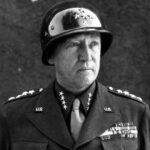
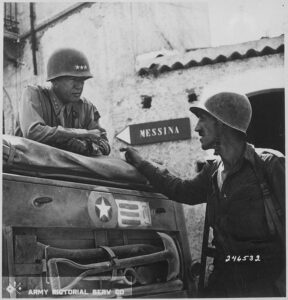 December of that year Patton’s great expertise in military movement and tank warfare helped to crush the German counteroffensive in the Ardennes.
December of that year Patton’s great expertise in military movement and tank warfare helped to crush the German counteroffensive in the Ardennes.
During one of his many successful campaigns, General Patton was said to have declared, “Compared to war, all other forms of human endeavor shrink to insignificance.” Patton died in a hospital in Germany on December 21, 1945, from injuries sustained in an automobile accident near Mannheim. He was just 60 years old.

 Most of us think of everything changing instantly when the Declaration of Independence was signed, and officially it did, but there was more to it than that. After years of oppression under the rulership of the British, the citizens of the 13 colonies had had enough. They formed the Continental Congress. The term “Continental Congress” most specifically refers to the First and Second Congresses of 1774–1781 and, at the time, was also used to refer to the Congress of the Confederation of 1781–1789, which operated as the first national government of the United States until being replaced under the Constitution of the United States. The 56 delegates to the Second Continental Congress represented the 13 colonies, 12 of which voted to approve the Declaration of Independence on July 4, 1776…our accepted day of Independence. The signing of the United States Declaration of Independence actually occurred on August 2, 1776, at the Pennsylvania State House in Philadelphia, which later to become known as Independence Hall. I suppose that a purist might insist that August 2nd should be our Independence Day, but the 56 delegates to the Second Continental Congress felt like once it was agreed upon, it was done. The signing was merely a technicality.
Most of us think of everything changing instantly when the Declaration of Independence was signed, and officially it did, but there was more to it than that. After years of oppression under the rulership of the British, the citizens of the 13 colonies had had enough. They formed the Continental Congress. The term “Continental Congress” most specifically refers to the First and Second Congresses of 1774–1781 and, at the time, was also used to refer to the Congress of the Confederation of 1781–1789, which operated as the first national government of the United States until being replaced under the Constitution of the United States. The 56 delegates to the Second Continental Congress represented the 13 colonies, 12 of which voted to approve the Declaration of Independence on July 4, 1776…our accepted day of Independence. The signing of the United States Declaration of Independence actually occurred on August 2, 1776, at the Pennsylvania State House in Philadelphia, which later to become known as Independence Hall. I suppose that a purist might insist that August 2nd should be our Independence Day, but the 56 delegates to the Second Continental Congress felt like once it was agreed upon, it was done. The signing was merely a technicality.
For the British government, neither of those days was acceptable, nor was the day they found out about the plan of the 13 colonies to gain their independence. In fact, that day…August 10, 1776, was the least acceptable day of all, because the British had no intention of giving the Colonies their independence…not without a fight anyway. When the news reached London, the British saw the conflict, centered in Massachusetts, as a local uprising within the British empire. Some Americans saw it that way too, but the reality is that the Declaration of Independence transformed the 13 British colonies into American states. King George III saw it as a colonial rebellion, but the Americans saw it as a struggle for their rights as British citizens. However, when Parliament continued to oppose any reform and remained unwilling to negotiate with the American rebels and instead hired Hessians, German mercenaries, to help the British army crush the rebellion, the Continental Congress began to pass measures abolishing British authority in the colonies. It was a brave move that would cost many of the 56 signers more than they could ever have imagined.
Following the signing of the Declaration of Independence, five of the signers were captured by the British and labeled as traitors. They were tortured before they died. Twelve of them had their homes ransacked and burned. Two lost their sons, who served in the Revolutionary War. Another two had sons captured, and nine of the 56 fought and died from wounds or hardships of the Revolutionary War. These men knew the risks they were taking. They knew that signing the Declaration of Independence very likely would cost them their lives. Nevertheless, they also knew that they couldn’t let the tyranny continue any longer. They had come to America to escape the tyrannical British government, and they could not allow the British government to make them slaves again. They signed, knowing they would likely die, but they saw no other way. These men weren’t soldiers…so, who were they. Twenty-four were lawyers and jurists. Eleven were merchants. Nine were farmers and plantation owners. All of them were men of means and well-educated, but they signed the Declaration of 
 Independence, knowing that the penalty would be death if they were captured. These men had their livelihood threatened and destroyed, their homes confiscated and sold, and some were threatened so badly that they had to constantly move their families from place to place. Still, not one of them saw this as one option of many. When it came to taking their country back, they saw it as the only option.
Independence, knowing that the penalty would be death if they were captured. These men had their livelihood threatened and destroyed, their homes confiscated and sold, and some were threatened so badly that they had to constantly move their families from place to place. Still, not one of them saw this as one option of many. When it came to taking their country back, they saw it as the only option.
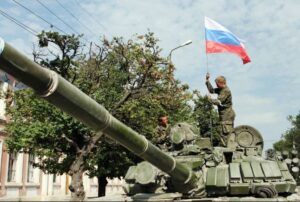 Georgia is a small nation that borders Russia, and in fact, was part of Russia at one time. The two nations had been at odds for a long time, and tempers just seemed to be simmering, with a deep heat that threatened to boil over into an all-out war. On August 8, 2008, the conflict finally hit the boiling point. What followed was a shooting war that while brief, was the most violent episode in a conflict that began more than a decade before.
Georgia is a small nation that borders Russia, and in fact, was part of Russia at one time. The two nations had been at odds for a long time, and tempers just seemed to be simmering, with a deep heat that threatened to boil over into an all-out war. On August 8, 2008, the conflict finally hit the boiling point. What followed was a shooting war that while brief, was the most violent episode in a conflict that began more than a decade before.
As the Union of Soviet Socialist Republics was breaking up in 1991, the nation of Georgia decided that it was time to declare their independence. A group of pro-Russian separatists decided that they were going to take control of two regions a short time later. The regions were composed of a combined 20 percent of Georgia’s territory, Abkhazia and South Ossetia. That, being unacceptable to Georgia, created a stalemate. In addition, in 2008, President George W Bush announced his support for Georgia’s and Ukraine’s membership in the North Atlantic Treaty Organization, something that should never have happened, and a move that Russia viewed as tantamount to putting a hostile military on its borders. I would have to agree with that assessment, and I think we are seeing the continued effects of that move to this day. I’m not saying that the people of Georgia and Ukraine are bad people, but the governments are questionable, causing Russia to take the steps it has taken.
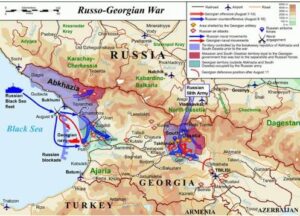
With relations between the two nations already tense in 2008, and the aggressive nature of Vladimir Putin, who is in power in Russia, Georgian President Mikheil Saakashvili, declared his intent to bring Abkhazia and South Ossetia back under Georgian control. This didn’t go over very well. Putin and Saakashvili accused each other of acts of aggression throughout the spring and summer of 2008. On August 1st, South Ossetian troops violated the ceasefire by shelling Georgian villages. Sporadic fighting and shelling ensued over the coming days, until Saakashvili declared a ceasefire on August 7th. The separatists refused to honor the cease fire, so Georgia’s military launched an attack on Tskhinvali in South Ossetia. Russian troops had already illegally entered South Ossetia, and so they responded quickly to the Georgian attack. The fighting spilled over into Abkhazia when Georgian troops seized Tskhinvali. The initial Georgian advance was pushed back and within a few days Russia seized most of the disputed territory and was advancing into Georgia proper. The two sides agreed to a ceasefire in the early hours of August 13th. While the war was short lived, it was fierce. During the five-day conflict, 170 servicemen, 14 policemen, and 228 civilians from Georgia were killed and 1,747 wounded. In addition, 67 Russian servicemen were killed and 283 were wounded, and 365 South Ossetian servicemen and civilians (combined) were killed.
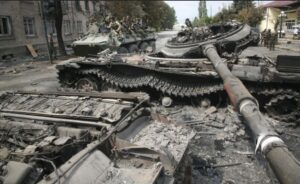
After the war, Russia formally recognized Abkhazia and South Ossetia as independent states, but stayed in occupation of them, in violation of the ceasefire. They took similar action concerning Ukraine in 2014, when they annexed the Crimean Peninsula, backing separatists in the west of the country. The Russo-Georgian War displaced an estimated 192,000 people, many of whom fled ethnic cleansing of Georgians in the separatist territories. The situation remained tense, and then once again came to a boiling point in 2022, as we have all seen.
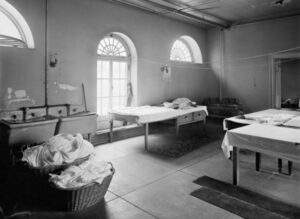
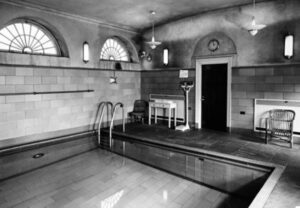 Construction began on the White House on October 13, 1792, and was finally finished on November 1, 1800. Construction was slower in those days, because they didn’t have the equipment we have today. The current White House has 132 rooms. The original White House had 100 rooms. The White House has 54,900 square feet. The White House sits on 18 acres of land. It all it is an impressive building, but there is more to it than just that.
Construction began on the White House on October 13, 1792, and was finally finished on November 1, 1800. Construction was slower in those days, because they didn’t have the equipment we have today. The current White House has 132 rooms. The original White House had 100 rooms. The White House has 54,900 square feet. The White House sits on 18 acres of land. It all it is an impressive building, but there is more to it than just that.
There have been a number of rooms that began as one thing, only to become something else later on. One of the rooms that has had a couple of identities is the Press Briefing Room. These days it is the James S. Brady Press Briefing Room. It was so named after White House Press Secretary James Brady, who was shot and permanently disabled during the assassination attempt on President Reagan. That room, located in the West Wing of the White House was not always such a necessary room, mostly because press briefings are really more of a modern-day thing. The room has always existed, however. In 1909, it was the White House laundry, and during President Truman’s time in office (April 12, 1945 – January 20,1953) it was the White House pool.
By 1950, the White House was 150 years old and in a serious state of disrepair. In order to make is inhabitable 
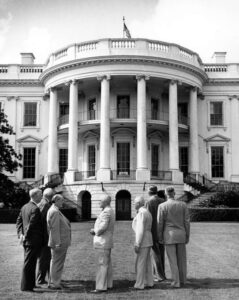 again, the entire building was gutted and rebuilt to make it more stable. It also seemed like a good time to improve on its design, so some improvements and additions were made. White House architect Lorenzo Simmons Winslow designed and built an air raid shelter under the East Terrace on the orders of naval aide Rear Admiral Robert Dennison. There had been a bomb shelter before, but it was built in 1942 and with the invention of the atomic bomb, the old shelter was not strong enough to withstand such an assault. Because little research had been conducted into how to withstand such an assault, construction of the shelter took more than two years and required the removal of the East Terrace entirely. Unfortunately, the 1952 shelter was rendered obsolete when the first test produced a force of 10.4 million tons. This shelter was designed to withstand a force of only 30,000 tons, so this would never work.
again, the entire building was gutted and rebuilt to make it more stable. It also seemed like a good time to improve on its design, so some improvements and additions were made. White House architect Lorenzo Simmons Winslow designed and built an air raid shelter under the East Terrace on the orders of naval aide Rear Admiral Robert Dennison. There had been a bomb shelter before, but it was built in 1942 and with the invention of the atomic bomb, the old shelter was not strong enough to withstand such an assault. Because little research had been conducted into how to withstand such an assault, construction of the shelter took more than two years and required the removal of the East Terrace entirely. Unfortunately, the 1952 shelter was rendered obsolete when the first test produced a force of 10.4 million tons. This shelter was designed to withstand a force of only 30,000 tons, so this would never work.
In addition to the new nuclear shelter, a tunnel was added. These days those tunnels are big in the news, but back then, they were probably a little-known addition. This reinforced concrete channel ran from the West Wing to the East Wing. Though not enough to stop a nuclear incident itself, the tunnel allowed quick passage from one end of the White House to the other, as well as access to the new air raid shelter. The presence of the tunnel demonstrates just how concerned the Truman White House was about securing itself against air assaults at that volatile time in history. That first tunnel inside the White House isn’t the only underground feature. In 1987, a second tunnel was built under the name Project ZP. That tunnel, accessible from a secret passage 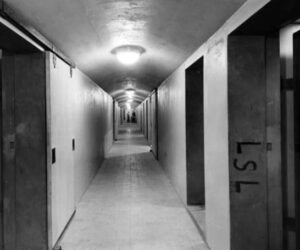
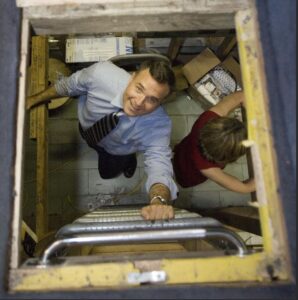 within the Oval Office, leads to the basement of the East Wing and on to the Treasury Building. Its construction, which was largely secret, created a large sinkhole in the White House rose garden. The tunnel was reportedly built to quickly get the president out of the office during an incursion, but it was also used at least once to sneak former president Richard Nixon into a foreign policy meeting. I’m sure there are other changes to the White House, that we are not privy to, and may never know, because there are always secrets in this kind of building.
within the Oval Office, leads to the basement of the East Wing and on to the Treasury Building. Its construction, which was largely secret, created a large sinkhole in the White House rose garden. The tunnel was reportedly built to quickly get the president out of the office during an incursion, but it was also used at least once to sneak former president Richard Nixon into a foreign policy meeting. I’m sure there are other changes to the White House, that we are not privy to, and may never know, because there are always secrets in this kind of building.
 There have been many firsts that our United States Presidents have been able to celebrate. One such first was “the first president to ride in a helicopter.” That particular first honor went to a well-known general turned president…Dwight D Eisenhower. On July 12, 1957, President Eisenhower became that first United States president to fly in a helicopter when a United States Air Force H-13J-BF Sioux, serial number 57-2729 (c/n 1576). The helicopter was piloted by Major Joseph E Barrett, USAF. It departed the White House lawn for Camp David, the presidential retreat in the Catoctin Mountains of Maryland. Of course, no presidential trip happens without a Secret Service agent, also on board. On that same day, a second H-13J, 57-2728 (c/n 1575), followed the first, this one carrying President Eisenhower’s personal physician and a second Secret Service agent.
There have been many firsts that our United States Presidents have been able to celebrate. One such first was “the first president to ride in a helicopter.” That particular first honor went to a well-known general turned president…Dwight D Eisenhower. On July 12, 1957, President Eisenhower became that first United States president to fly in a helicopter when a United States Air Force H-13J-BF Sioux, serial number 57-2729 (c/n 1576). The helicopter was piloted by Major Joseph E Barrett, USAF. It departed the White House lawn for Camp David, the presidential retreat in the Catoctin Mountains of Maryland. Of course, no presidential trip happens without a Secret Service agent, also on board. On that same day, a second H-13J, 57-2728 (c/n 1575), followed the first, this one carrying President Eisenhower’s personal physician and a second Secret Service agent.
While that first flight was really a pleasure ride, the main purpose of the helicopter was to rapidly move the 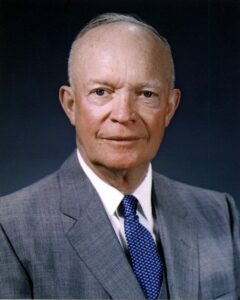 president from the White House to Andrews Air Force Base where his Lockheed VC-121E Constellation, Columbine III, would be standing by. This was intended to be a way of escape to Andrews or to other secure facilities in case of an emergency. Major Barrett was selected as the pilot because of his extensive experience as a combat pilot. They needed someone who was a capable pilot under pressure, a skill that Major Barrett proved he possessed during World War II, when he flew the B-17 Flying Fortress four-engine heavy bomber. Major Barrett was credited with carrying out a helicopter rescue 70 miles behind enemy lines during the Korean War. For his heroics, he was awarded the Silver Star.
president from the White House to Andrews Air Force Base where his Lockheed VC-121E Constellation, Columbine III, would be standing by. This was intended to be a way of escape to Andrews or to other secure facilities in case of an emergency. Major Barrett was selected as the pilot because of his extensive experience as a combat pilot. They needed someone who was a capable pilot under pressure, a skill that Major Barrett proved he possessed during World War II, when he flew the B-17 Flying Fortress four-engine heavy bomber. Major Barrett was credited with carrying out a helicopter rescue 70 miles behind enemy lines during the Korean War. For his heroics, he was awarded the Silver Star.
Not only was the helicopter a great way to quickly secure the president, but that original pilot was the perfect person to make sure that the president was safely transferred to that secure location. The President of the United States is always in a degree of danger. It goes with the territory I suppose. It is the job of his security details is to make sure that no threats are ever able to be carried out. They are very loyal and would die to protect the president.
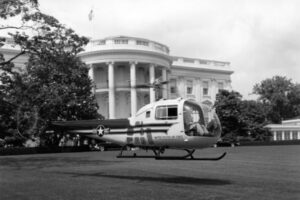
The Bell Helicopter Company of Fort Worth, Texas, manufactured two of the helicopters. They were delivered to the Air Force at Wright-Patterson Air Force Base on March 29, 1957. The two presidential H-13Js were nearly identical to the commercial Bell Model 47J Ranger. They were capable of carrying a pilot and up to three passengers. An enclosed cabin was built on a tubular steel framework with all-metal semi-monocoque tail boom. The main rotor was 37 feet 2 inches in diameter and tail rotor was 5 feet 10.13 inches, making the helicopter an overall length of 43 feet 3¾ inches with rotors turning. It stood 9 feet 8 inches and weighed 2,800 pounds.
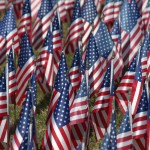
 It seems to me that with each Independence Day, the fight for our freedom grows more and more fierce. Our current political situation is not a matter of Republican against Democrat, but rather, Good against Evil. I suppose one might have their own opinion as to which side is which, but those who know me, know exactly where I stand. I am a firm believer in this statement by Thomas Jefferson, “When the people fear the government, there is tyranny. When the government fears the people, there is liberty.” The good news for the good people of this nation is that we know how to pray, and we know how to fight. What we don’t know how to do is to give up. It may take us a little while, but with God’s help we will prevail…and God is on our side.
It seems to me that with each Independence Day, the fight for our freedom grows more and more fierce. Our current political situation is not a matter of Republican against Democrat, but rather, Good against Evil. I suppose one might have their own opinion as to which side is which, but those who know me, know exactly where I stand. I am a firm believer in this statement by Thomas Jefferson, “When the people fear the government, there is tyranny. When the government fears the people, there is liberty.” The good news for the good people of this nation is that we know how to pray, and we know how to fight. What we don’t know how to do is to give up. It may take us a little while, but with God’s help we will prevail…and God is on our side.
Pretty much every year, my husband, Bob Schulenberg and I go to the Black Hills for the holiday. The fireworks 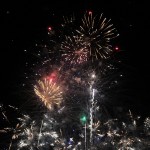
 display in Custer, South Dakota is one of the best we’ve ever seen. The amazing thing is that Custer is a really small town…in fact, it has a population of only about 2,314 people. That said, for them to put on such an amazing fireworks display is really cool. Pageant Hill starts filling up early, so if you are driving up there, you need to go well before dusk. Bob and I would rather walk up there, because it’s easy to find a place to sit when you don’t have a car, and when the show is over, we don’t have to wait for all that traffic to get back to our room. That fireworks display is one of the main highlights of the trip.
display in Custer, South Dakota is one of the best we’ve ever seen. The amazing thing is that Custer is a really small town…in fact, it has a population of only about 2,314 people. That said, for them to put on such an amazing fireworks display is really cool. Pageant Hill starts filling up early, so if you are driving up there, you need to go well before dusk. Bob and I would rather walk up there, because it’s easy to find a place to sit when you don’t have a car, and when the show is over, we don’t have to wait for all that traffic to get back to our room. That fireworks display is one of the main highlights of the trip.
Of course, the fireworks display is not the only thing Bob and I like to do in the Black Hills. Our main focus is hiking. There are so many beautiful trails in the area. We take a different one each day that we are there. There is no better way to experience freedom and liberty, than a hike in the woods. It is so peaceful out there, and 
 absolutely beautiful. There are many places that you just can’t see driving down the road. Wildlife, mostly birds, because the bigger animals make themselves scarce…thankfully for the most part. I like seeing deer, but I draw the line at the mountain lions. There are no bears in the Black Hills, except at Bear Country USA, which is a wildlife park, and the bears don’t run free in the Black Hills. Bears don’t run free there, but we definitely do. Happy Independence Day everyone!! Let Freedom Ring!!!
absolutely beautiful. There are many places that you just can’t see driving down the road. Wildlife, mostly birds, because the bigger animals make themselves scarce…thankfully for the most part. I like seeing deer, but I draw the line at the mountain lions. There are no bears in the Black Hills, except at Bear Country USA, which is a wildlife park, and the bears don’t run free in the Black Hills. Bears don’t run free there, but we definitely do. Happy Independence Day everyone!! Let Freedom Ring!!!

